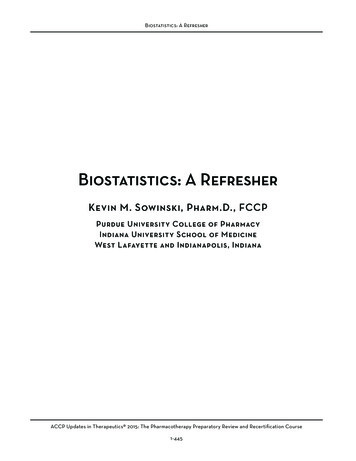
Transcription
Biostatistics: A RefresherBiostatistics: A RefresherKevin M. Sowinski, Pharm.D., FCCPPurdue University College of PharmacyIndiana University School of MedicineWest Lafayette and Indianapolis, IndianaACCP Updates in Therapeutics 2015: The Pharmacotherapy Preparatory Review and Recertification Course1-445
Biostatistics: A RefresherLearning ObjectivesA. Kruskal-Wallis.1. Describe differences between descriptive andinferential statistics.2. Identify different types of data (nominal, ordinal,continuous [ratio and interval]) to determine anappropriate type of statistical test (parametric vs.nonparametric).3. Describe strengths and limitations of differenttypes of measures of central tendency (mean,median, and mode) and data spread (standard deviation, standard error of the mean, range, and interquartile range).4. Describe the concepts of normal distributionand the associated parameters that describe thedistribution.5. State the types of decision errors that can occurwhen one is using statistical tests and the conditions under which they can occur.6. Describe hypothesis testing and state the meaningof and distinguish between p-values and confidence intervals.7. Describe areas of misuse or misrepresentation thatare associated with various statistical methods.8. Select appropriate statistical tests on the basis of thesample distribution, data type, and study design.9. Interpret statistical significance for results fromcommonly used statistical tests.10. Describe the similarities and differencesbetween statistical tests; state how to apply themappropriately.11. Identify the use of survival analysis and differentways to perform and report it.Self-Assessment QuestionsAnswers and explanations to these questions can befound at the end of the chapter.1. A randomized controlled trial assesses the effectsof heart failure treatment on global functioning inthree groups of adults after 6 months of treatment.Investigators wanted to assess global functioningwith the New York Heart Association (NYHA)functional classification, an ordered scale from I toIV, and to compare the patient classification after 6months of treatment. Which statistical test is mostappropriate to assess differences in functional classification between the groups?B. Wilcoxon signed rank test.C. Analysis of variance (ANOVA).D. Analysis of covariance (ANCOVA).2. You are evaluating a randomized, double-blind,parallel-group controlled trial that compares fourantihypertensive drugs for their effect on bloodpressure. The authors conclude that hydrochlorothiazide is better than atenolol (p 0.05) and that enalapril is better than hydrochlorothiazide (p 0.01),but no difference is observed between any otherdrugs. The investigators used an unpaired (independent samples) t-test to test the hypothesis thateach drug was equal to the other. Which statementis most appropriate?A. Investigators used the appropriate statisticaltest to analyze their data.B. Enalapril is the most effective of these drugs.C. ANOVA would have been a more appropriatetest.D. A paired t-test is a more appropriate test.3. In the results of a randomized, double-blind, controlled clinical trial, it is reported that the difference in hospital readmission rates between theintervention group and the control group is 6%(p 0.01), and it is concluded that there is a statistically significant difference between the groups.Which statement is most consistent with this finding and conclusions?A. The chance of making a type I error is5 in 100.B. The trial does not have enough power.C. There is a high likelihood of having madea type II error.D. The chance of making an alpha error is1 in 100.4. You are reading a manuscript that evaluates theimpact of obesity on enoxaparin pharmacokinetics. The authors used an unpaired t-test to comparethe baseline values of body mass index (BMI) innormal subjects and obese subjects. You are evaluating the use of an unpaired t-test to comparethe BMI between the two groups. Which choiceACCP Updates in Therapeutics 2015: The Pharmacotherapy Preparatory Review and Recertification Course1-446
Biostatistics: A Refresherrepresents the most appropriate criteria to be metto use this parametric test?A. An a priori α of less than 0.10 would havemade the study more clinically useful.A. The sample sizes in the normal and obesesubjects should be equal to allow the use ofa t-test.B. The new drug and active control appear to beequally efficacious in increasing HDL-C.C. The new drug is better than lifestyle modifications because it increases HDL-C to agreater extent.B. A t-test is not appropriate because BMI dataare ordinal.C. The variance of the BMI data needs must besimilar in each group.D. This study is potentially underpowered.D. The pre-study power should be at least 90%.5. You are evaluating the results and discussion ofa journal club article to present to the pharmacyresidents at your institution. The randomized, prospective, controlled trial evaluated the efficacy of anew controller drug for asthma. The primary endpoint was the morning forced expiratory volumein 1 second (FEV1) in two groups of subjects (menand women). The difference in FEV1 between thetwo groups was 15% (95% confidence interval[CI], 10%–21%). Which statement is most appropriate, given the results?A. Without the reporting of a p-value, it is notpossible to conclude whether these resultswere statistically significant.7. Researchers planned a study to evaluate the percentage of subjects who achieved less than a target blood pressure (less than 140/90 mm Hg) wheninitiated on two different doses of amlodipine. Inthe study of 100 subjects, the amlodipine 5-mggroup (n 50) and the amlodipine 10-mg group(n 50) were compared. The investigators used ablood pressure goal as their primary end point,defined as the percentage of subjects who successfully achieved the blood pressure goal at 3 months.Which is the most appropriate statistical test toanswer such a question?A. Independent samples t-test.B. Chi-square or Fisher exact test.C. Wilcoxon signed rank test.D. One-sample t-test.B. There is a statistically significant differencebetween the men and women (p 0.05).C. There is a statistically significant differencebetween the men and women (p 0.01).D. There is no statistically significant differencebetween the men and women.6. An early-phase clinical trial of 40 subjects evaluated a new drug known to increase high-densitylipoprotein cholesterol (HDL-C) concentrations.The objective of the trial was to compare the newdrug’s ability to increase HDL-C with that of lifestyle modifications (active control group). At thebeginning of the study, the mean baseline HDL-Cwas 37 mg/dL in the active control group and38 mg/dL in the new drug group. At the end of the3-month trial, the mean HDL-C for the controlgroup was 44 mg/dL and for the new drug group,49 mg/dL. The p-value for the comparison at3 months was 0.08. Which statement provides thebest interpretation of these results?8. An investigational drug is being compared withan existing drug for the treatment of anemia inpatients with chronic kidney disease. The study isdesigned to detect a minimum 20% difference inresponse rates between the groups, if one exists,with an a priori α of 0.05 or less. The investigatorsare unclear whether the 20% difference betweenresponse rates is too large and think a smallerdifference might be more clinically meaningful.In revising their study, they decide they want tobe able to detect a minimum 10% difference inresponse. Which change in the study parameters ismost appropriate?A. Increase the sample size.B. Select an α of 0.001 as a cutoff for statisticalsignificance.C. Select an α of 0.10 as a cutoff for statisticalsignificance.D. Decrease the sample size.ACCP Updates in Therapeutics 2015: The Pharmacotherapy Preparatory Review and Recertification Course1-447
Biostatistics: A Refresher9. You are designing a new computer alert system toinvestigate the impact of several factors on the riskof QTc prolongation. You want to develop a modelto predict which patients are most likely to experience QTc prolongation after the administration ofcertain drugs or the presence of certain conditions.You plan to assess the presence or absence of several different variables. Which technique will bemost useful in completing such an analysis?A. Correlation.B. Kaplan-Meier curve.C. Regression.D. Confidence intervals.ACCP Updates in Therapeutics 2015: The Pharmacotherapy Preparatory Review and Recertification Course1-448
Biostatistics: A RefresherI.INTRODUCTION TO STATISTICSA. Method for Collecting, Classifying, Summarizing, and Analyzing DataB. Useful Tool for Quantifying Clinical and Laboratory Data in a Meaningful WayC. Assists in Determining Whether and by How Much a Treatment or Procedure Affects a Group of PatientsD. Why Pharmacists Need to Know StatisticsE. As Statistics Pertains to Most of You:1. Pharmacotherapy Specialty Examination content outline Domain 2: Retrieval, Generation, Interpretation, and Dissemination of Knowledge in Pharmacotherapy(25%) Interpret biomedical literature with respect to study design and methodology, statistical analysis, andsignificance of reported data and conclusions. K nowledge of biostatistical methods, clinical and statistical significance, research hypothesis generation, research design and methodology, and protocol and proposal developmentF. Several articles have investigated the various types of statistical tests used in the biomedical literature; thedata from one of these articles are illustrated below.Table 1. Statistical Content of Original Articles in The New England Journal of Medicine, 2004–2005Statistical Procedure% of ArticlesContaining MethodsStatistical Procedure% of ArticlesContaining MethodsNo statistics or descriptivestatisticst-tests13Adjustment and standardization126Multiway tables13Contingency tables53Power analyses39Nonparametric tests27Cost-benefit analysis 1Epidemiologic statistics35Sensitivity analysis6Pearson correlation3Repeated-measures analysis12Simple linear regression6Missing data methods8Analysis of variance16Noninferiority trials4TransformationNonparametric correlation105Receiver operating characteristicsResampling22Survival methods612Multiple regression51Principal component and clusteranalysesOther methodsMultiple comparisons234ACCP Updates in Therapeutics 2015: The Pharmacotherapy Preparatory Review and Recertification Course1-449
Biostatistics: A RefresherTable 2. Statistical Content of Original Articles from Six Major Medical Journals from January to March 2005(n 239 articles).Statistical TestDescriptive statistics (mean,median, frequency, SD, and IQR)No. (%)Statistical TestNo. (%)219 (91.6)OthersSimple statistics120 (50.2)Intention-to-treat analysis42 (17.6)Chi-square analysis70 (29.3)Incidence or prevalence39 (16.3)t-test48 (20.1)Relative risk or risk ratio29 (12.2)Kaplan-Meier analysis48 (20.1)Sensitivity analysis21 (8.8)Wilcoxon rank sum test38 (15.9)Sensitivity or specificity15 (6.3)Fisher exact test33 (13.8)Analysis of variance21 (8.8)Correlation16 (6.7)Multivariate analysis164 (68.6)Cox proportional hazards64 (26.8)Multiple logistic regression54 (22.6)Multiple linear regression7 (2.9)Other regression analysis38 (15.9)None5 (2.1)IQR interquartile range; SD standard deviation.Articles published in American Journal of Medicine, Annals of Internal Medicine, BMJ, JAMA, Lancet, and The New England Journal ofMedicine. Table modified from JAMA 2007;298:1010-22.II. TYPES OF VARIABLES AND DATAA. Definition: Random variables—A variable with observed values that may be considered outcomes of anexperiment and whose values cannot be anticipated with certainty before the experiment is conductedB. Two Types of Random Variables1. Discrete variables (e.g., dichotomous, categorical)2. Continuous variablesC. Discrete Variables1. Can take only a limited number of values within a given range2. Nominal: Classified into groups in an unordered manner and with no indication of relative severity (e.g.,male/female sex, mortality [dead or alive], disease presence [yes or no], race, marital status). These dataare often expressed as a frequency or proportion.3. Ordinal: Ranked in a specific order but with no consistent level of magnitude of difference betweenranks (e.g., New York Heart Association [NYHA] functional class describes the functional status ofpatients with heart failure, and subjects are classified in increasing order of symptoms: I, II, III, IV;Likert-type scales)4. Common error: Measure of central tendency—In most cases, means and standard deviations (SDs)should not be reported with ordinal data. What is a common incorrect use of means and SDs to showordinal data?ACCP Updates in Therapeutics 2015: The Pharmacotherapy Preparatory Review and Recertification Course1-450
Biostatistics: A RefresherD. Continuous Variables, Sometimes Called Counting Variables1. Continuous variables can take on any value within a given range.2. Interval: Data are ranked in a specific order with a consistent change in magnitude between units; thezero point is arbitrary (e.g., degrees Fahrenheit).3. Ratio: Like interval but with an absolute zero (e.g., degrees Kelvin, heart rate, blood pressure, time,distance)III. TYPES OF STATISTICSA. Descriptive Statistics: Used to summarize and describe data that are collected or generated in research studies. This is done both visually and numerically.1. Visual methods of describing dataa. Frequency distributionb. Histogramc. Scatterplot2. Numerical methods of describing data: Measures of central tendencya. Arithmetic mean (i.e., average)i. Sum of all values divided by the total number of valuesii. Should generally be used only for continuous and normally distributed dataiii. Very sensitive to outliers and tend toward the tail, which has the outliersiv. Most commonly used and most understood measure of central tendencyv. Geometric meanb. Mediani. M
ACCP Udates in Therapeutics 2015: The Pharmacotherapy Preparatory Review Recertification Course 1-447 represents the most appropriate criteria to be met to use this parametric test? A. The sample sizes in the normal and obese subjects should be equal to allow the use of a t-test. B. A t-test is not appropriate because BMI data are ordinal. C. The variance of the BMI data needs must be

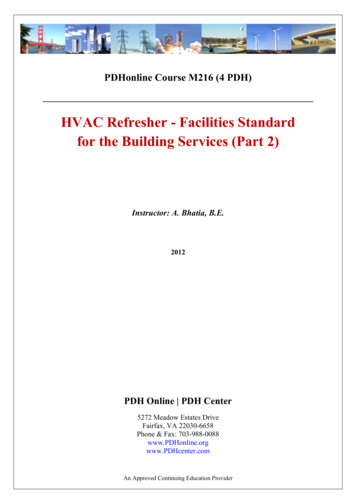
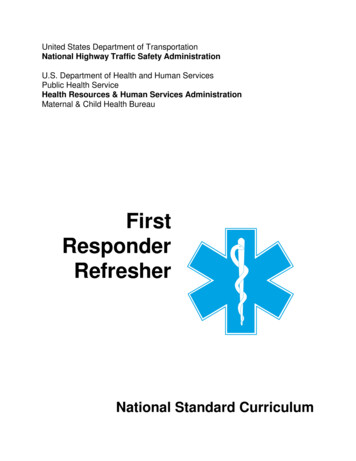

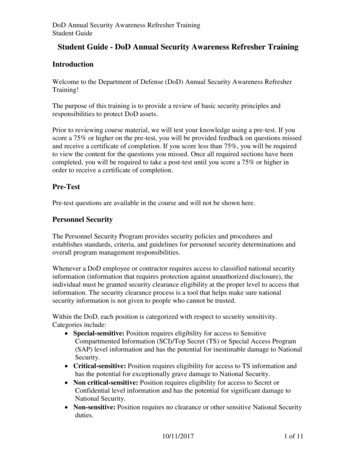
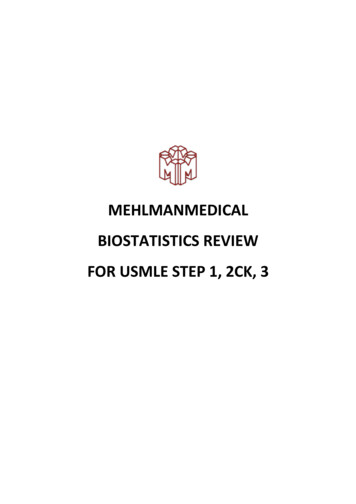
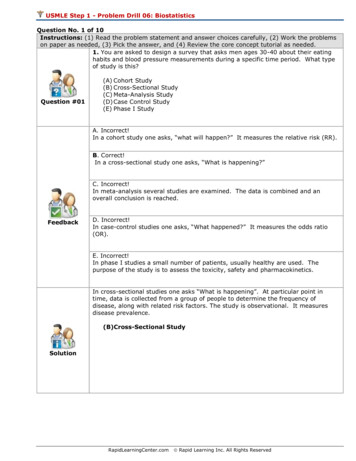
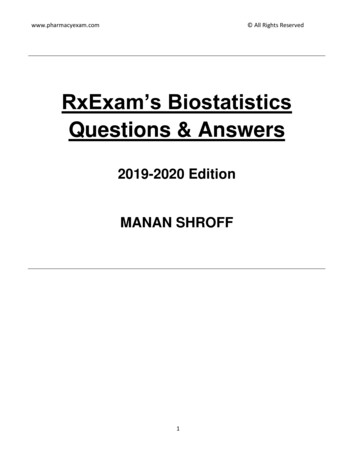
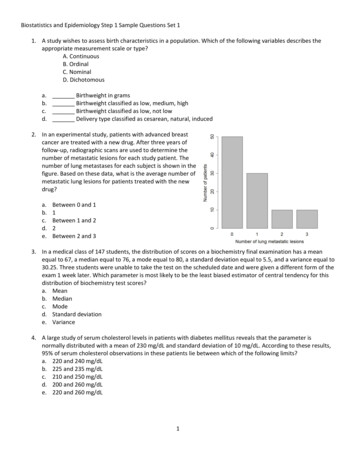
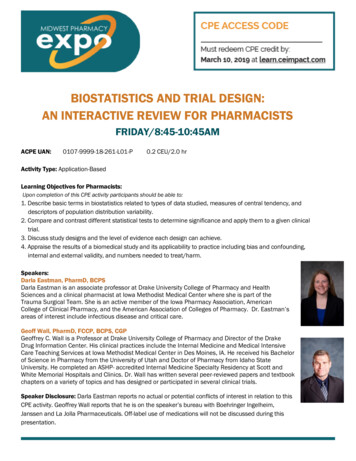
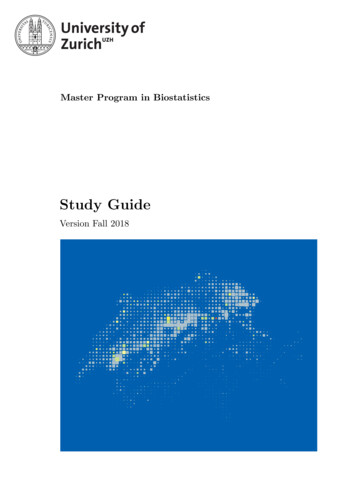
![Clinical Biostatistics [CLB]](/img/6/study-guide-clb-2021.jpg)